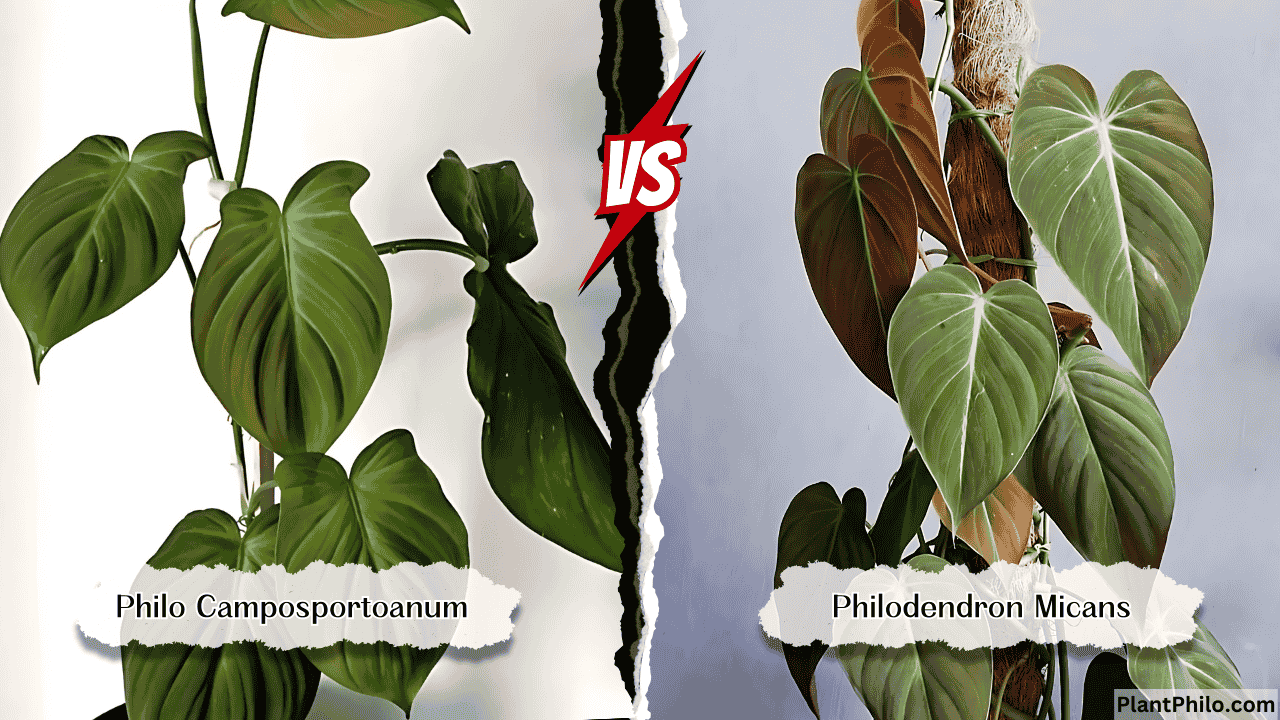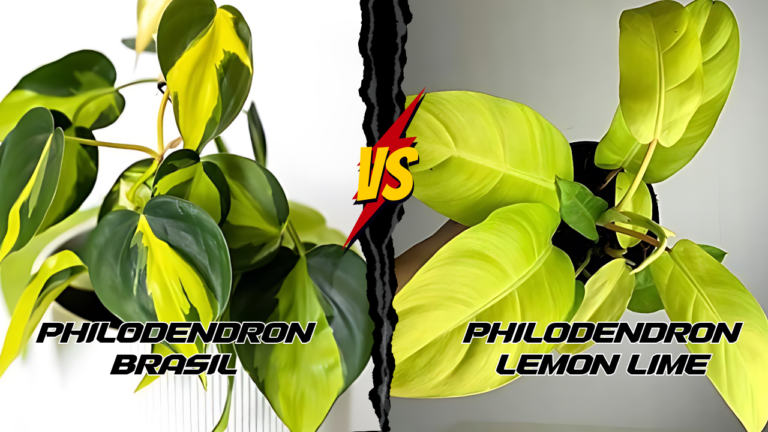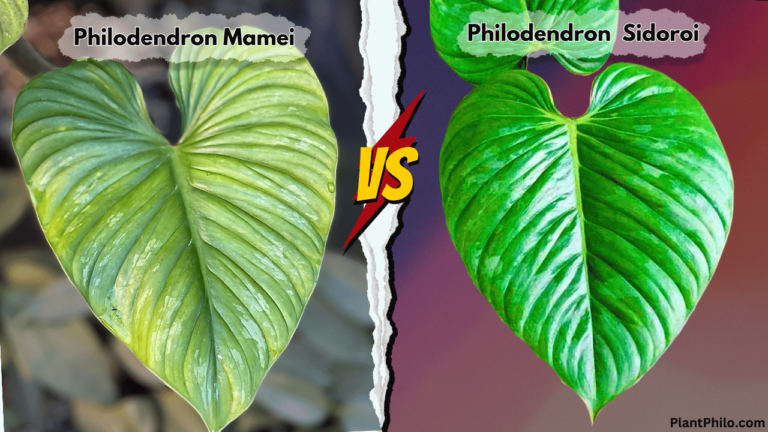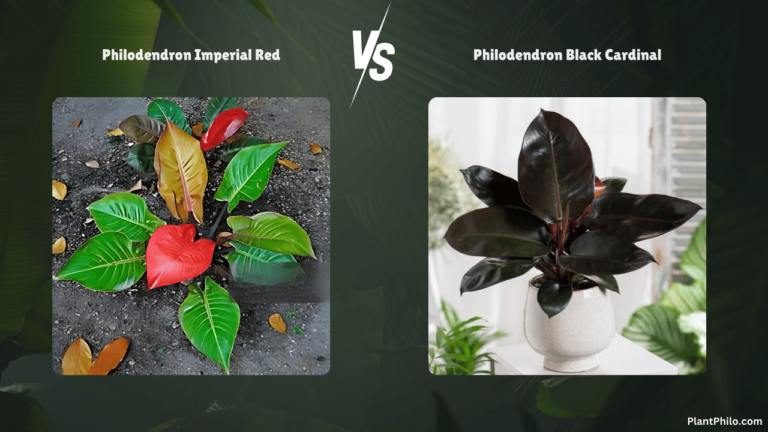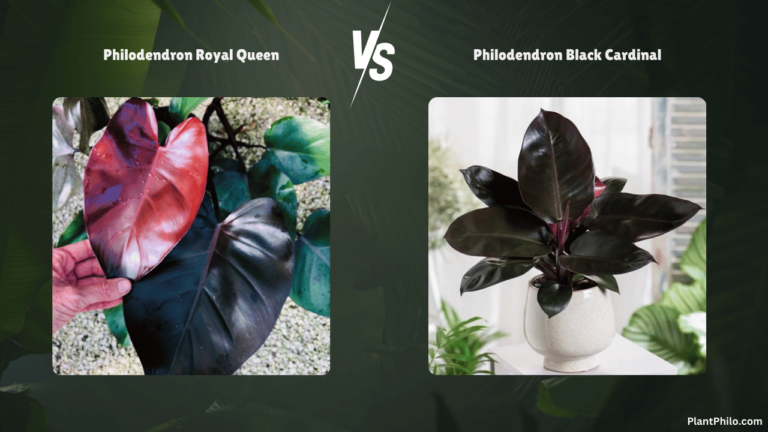Philo Camposportoanum vs. Micans: Don’t Be Fooled! These Philo Look-Alikes Have Very Different Needs
Philodendron Camposportoanum vs. Micans: these are two types of houseplants that many people like. They’re both part of the Philodendron family, but they look and grow quite differently. This article will help you understand these plants better. We’ll look at how they grow, what they need to be healthy, and what makes them special.
Before we dive into the Philodendron Camposportoanum vs. Micans debate, let’s get to know our leafy contestants.
Getting to Know the Plants
Philodendron Camposportoanum
Philodendron Camposportoanum comes from Brazil. It’s special because its leaves change shape as they grow. This doesn’t happen with many plants, which makes Camposportoanum interesting to plant lovers.
Important things to know:
- The leaves start small and arrow-shaped
- As the plant grows, the leaves become three-lobed (they look like they have three fingers)
- It grows slowly and stays fairly small
- It’s not very common, so it can be hard to find
Philodendron Micans
Philodendron Micans comes from the Caribbean. People love it because its leaves feel like velvet and shine in the light.
Important things to know:
- The leaves are heart-shaped and feel soft
- The plant can climb or trail down from a pot
- It grows quickly
- It’s easier to find in stores than Camposportoanum
Comparison Table: Camposportoanum vs. Micans
| Feature | Philodendron Camposportoanum | Philodendron Micans |
| Botanical Name | Philodendron camposportoanum | Philodendron hederaceum var. hederaceum |
| Common Names | Campos Philodendron | Velvet-Leaf Philodendron, Heartleaf Philodendron |
| Origin | Brazil | Central America & the Caribbean |
| Growth Habit | Vining, climbing with support | Vining, climbing or trailing |
| Leaf Shape & Size | Heart-shaped, elongated, 3-6 inches long | Heart-shaped, 2-4 inches long |
| Color | Velvety, deep green with lighter veins, new leaves often bronze or reddish | Iridescent, velvety leaves shifting from bronze to deep green with hints of purple or red depending on light |
| Light Requirements | Bright, indirect light for optimal color; tolerates low light but colors may fade | Bright, indirect light for optimal iridescence; tolerates low light but colors may fade |
| Watering Needs | Water when top 2-3 inches of soil are dry | Water when top inch of soil is dry |
| Humidity | Appreciates higher humidity but tolerates average levels with extra care | Thrives in higher humidity (60-80%), tolerates average levels with extra care |
| Fertilizing | Balanced liquid fertilizer diluted to half-strength, monthly during growing season | Balanced liquid fertilizer diluted to half-strength, monthly during growing season |
| Common Pests & Diseases | Mealybugs, scale, spider mites | Mealybugs, scale, spider mites |
| Propagation | Stem cuttings in water or soil | Stem cuttings in water or soil |
| Toxicity | Toxic to pets and humans if ingested | Toxic to pets and humans if ingested |
| Petiole | Slender, often reddish | Slender, often reddish |
| Stem | Thin, vining, develops aerial roots | Thin, vining, develops aerial roots |
| New Leaf Color | Bronze or reddish, maturing to deep green | Bronze or copper, maturing to iridescent green |
| Air Purifying | Moderate air purifying qualities | Moderate air purifying qualities |
| Overall Difficulty | Moderately easy to care for | Easy to care for |
| Mature Size | Can reach 6-10 feet with support | Can reach 6-10 feet with support |
Growth Habit
Both plants are enthusiastic climbers, eager to reach new heights with the help of a moss pole or trellis. Picture them as agile acrobats, gracefully scaling any support you provide.
They can also be trained to trail downwards from a hanging basket, creating a cascading waterfall of foliage. When we compare how Philodendron Camposportoanum vs. Micans grow, we see big differences.
Camposportoanum grows slowly. It doesn’t get very big, which is good if you don’t have much space. Its unique leaf development process, transitioning from simple to complex shapes, occurs over an extended period.
This gradual growth makes it suitable for smaller spaces or as a specimen plant. It’s exciting to watch because the leaves change shape as they grow. This slow growth means you won’t need to repot it very often.
Micans grows much faster. It’s a vine, which means it can get quite long. You might need to cut it back sometimes to keep it from getting too big. It’s great if you want a plant that will quickly fill a space or hang down from a shelf.
In-Depth Comparison: Camposportoanum vs. Micans
Leaf Shape & Size
Both the Camposportoanum and Micans sport heart-shaped leaves that add a touch of romance to your plant collection. The Camposportoanum’s leaves are slightly more elongated, lending it a touch of elegance.
The Micans’ leaves, while also heart-shaped, are a tad smaller and rounder, almost like a perfect Valentine’s Day heart. Think of it as comparing a classic love song to a playful love note – both express affection, but in slightly different ways.
Color: Velvet vs. Iridescence
Both plants showcase captivating colors, but with distinct textures. The Camposportoanum flaunts velvety, deep green leaves with lighter-colored veins. Its new leaves often emerge in a bronze or reddish hue, adding a touch of warmth to its overall appearance.
The Micans, on the other hand, is a true showstopper with its iridescent foliage. Its leaves shimmer and change color depending on the light, shifting from bronze to deep green with hints of purple or red. It’s like having a living gemstone in your home, constantly dazzling you with its ever-changing beauty.
Light
Both the Camposportoanum and Micans thrive in bright, indirect light. This helps them maintain their vibrant colors and encourages healthy growth.
While they can tolerate lower light conditions, their colors might fade, and their growth might slow down. Avoid direct sunlight, as it can scorch their delicate leaves. However, they have some differences:
- Camposportoanum can handle less light. It can adapt to lower light conditions, maintaining its growth pattern and leaf development, albeit at a slower rate. It will still grow even if it’s not in a very bright spot, but slower.
- Micans needs more light. If it doesn’t get enough, its leaves might lose their pretty color and soft texture.
Water
When it comes to watering, strike a balance between keeping the soil moist but not soggy. Allow the top 2-3 inches of soil to dry out for the Camposportoanum and the top inch for the Micans before reaching for your watering can.
For both plants, it’s important not to give too much water. Too much water can make the roots rot, which is bad for the plant. The water needs of Philodendron Camposportoanum vs. Micans show some variation:
- Camposportoanum doesn’t need a lot of water. It displays moderate drought tolerance. Let the top of the soil dry out before you water it again.
- Micans likes the soil to stay a bit damp. But be careful not to give it too much water, or the roots might rot.
Humidity Preferences
Hailing from tropical regions, both plants appreciate a humid environment. Think of it as a gentle mist on a warm summer morning.
While they can tolerate average household humidity, they’ll flourish in higher humidity levels (60-80%). You can increase humidity by misting them regularly, using a pebble tray, or running a humidifier. This is important for these plants:
- Camposportoanum likes high humidity. It benefits from higher humidity levels, typically above 60%. In less humid environments, supplemental misting or a humidifier may be necessary. If the air in your home is dry, you might need to mist it or use a humidifier.
- Micans is more flexible. It can do well in normal house conditions, but it will be happier if the air is a bit humid. It adapts well to average indoor humidity levels, typically performing well in conditions above 50% humidity.
Soil and Fertilizer Requirements
Both species benefit from well-draining, nutrient-rich soil. A mixture of potting soil, perlite, and orchid bark in equal parts provides an optimal growing medium for both Philodendron Camposportoanum and Micans. Both plants benefit from a monthly dose of diluted liquid fertilizer during their growing season.
Fertilizer needs differ slightly:
- Camposportoanum requires less frequent fertilization. A monthly application of balanced, water-soluble fertilizer at half-strength during the growing season is typically sufficient. Give it plant food once a month when it’s growing (usually in spring and summer).
- Micans, with its faster growth rate, benefits from bi-weekly fertilization during the active growing period. You can give plant food every two weeks when it’s growing because it grows faster.
Propagation Methods
Both the Camposportoanum and Micans can be easily propagated from stem cuttings. Simply take a cutting with at least one node and place it in water or moist soil. If you want to make more of these plants, here’s how it works for Philodendron Camposportoanum vs. Micans:
Micans is easy to make more of. You can cut a piece of the stem, put it in water or soil, and it will grow roots in 2-3 weeks.
Camposportoanum is harder to make more of. You can try the same method, but it takes longer, often 3-4 weeks or more, for roots to grow.
Dealing with Pests and Problems
Both plants are generally good at fighting off pests, but they can have some issues. But, they’re also susceptible to the same common houseplant pests, such as mealybugs, scale, and spider mites. Vigilance and prompt treatment are key to keeping these pests at bay.
Micans might get spider mites, especially if the air is dry. These are tiny bugs that can damage the plant. Regular inspection and maintaining adequate humidity can help prevent infestations.
Camposportoanum sometimes gets mealybugs, especially in the crevices of its lobed leaves. Routine checks and prompt treatment are advisable. Mealybugs look like little bits of cotton on the plant.
Overall Difficulty & Mature Size
Both plants are considered moderately easy to care for, making them suitable for plant enthusiasts of various skill levels. The Micans, with its slightly higher tolerance for average humidity, might have a slight edge for beginners.
Both plants can reach a mature size of 6-10 feet with support, so ensure you have enough space for them to climb and flourish.
Safety Around Pets and Children
When comparing Philodendron Camposportoanum vs. Micans, it’s important to know that both plants can be harmful if eaten. While these plants are visually stunning, they’re not meant for consumption. They contain substances that can irritate the mouth and stomach.
Both contain calcium oxalate crystals, which can cause irritation and swelling if ingested. If you have pets or small children, keep these plants out of reach.
Market Availability and Economic Factors
It’s easier to find and buy Micans than Camposportoanum:
Micans has become more common in recent years. Its ease of propagation has led to wider distribution in the horticultural trade, resulting in more affordable prices. Many plant shops sell it, and it’s usually not too expensive.
Camposportoanum is harder to find. Because it’s rare and grows slowly, it often costs more money. Its slower growth and unique characteristics contribute to higher market prices and limited availability.
Aesthetic Considerations
The visual appeal of Philodendron Camposportoanum vs. Micans is subjective, but each offers distinct aesthetic qualities. Both plants are beautiful, but in different ways:
Camposportoanum is interesting to look at because its leaves change shape as they grow. It stays compact, so it’s good as a special display plant.
Micans has soft, lush, shiny leaves that look great hanging down from a pot or climbing up a support. It can quickly make a space look green and lush.
Space and Temperature Needs
When choosing between Philodendron Camposportoanum vs. Micans, think about the indoor cultivation, space requirements and climate adaptability are crucial factors:
Camposportoanum doesn’t need much space. It grows slowly and stays small, so it’s good for small areas or as a tabletop plant. Its adaptability to various light conditions allows for flexible placement within indoor environments.
Micans needs more space as it grows. You’ll need to give it room to spread out or climb or be ready to trim it regularly.
Both plants like warm temperatures, between 65-80°F (18-27°C). This is usually fine for most homes. Micans might be more sensitive to cold drafts, so keep them away from cold windows in winter.
Caring for Your Plant Over Time
As your plant grows, you’ll need to care for it differently. Here’s what to expect with Philodendron Camposportoanum vs. Micans:
Camposportoanum:
- It grows slowly, so you won’t need to repot it often. Maybe every 2-3 years.
- As it grows, you might need to give it something to climb on, like a small trellis.
- The changing leaf shapes mean your plant will look different as it gets older, which is exciting for many plant owners.
Micans:
- It grows quickly, so you might need to repot it every year.
- You’ll need to decide if you want it to climb up or trail down. If climbing, give it a pole or trellis to grow on.
- Regular trimming will keep it looking full and bushy.
Seasonal Care
The care for these plants changes a bit with the seasons:
Spring and Summer:
- Both plants grow more during these seasons.
- You’ll water and feed them more often.
- For Micans, you might need to trim it more to control its growth.
Fall and Winter:
- Growth slows down for both plants.
- Water less often, letting the soil dry out more between waterings.
- Stop feeding, or feed much less often.
- For Camposportoanum, the lower light in winter might slow its growth even more.
Making Your Decision
Choosing between Philodendron Camposportoanum vs. Micans depends on what you want and can provide:
Choose Camposportoanum if:
- You have a small space
- You like plants that change as they grow
- You don’t mind slow growth
- You can provide higher humidity
- You’re willing to pay more for a rare plant
Choose Micans if:
- You want fast growth
- Do you like the look of vining plants
- You can provide brighter light
- You want a plant that’s easier to care for
- Do you prefer a less expensive option
Remember, there’s no wrong choice. Both plants are beautiful and can be great additions to your home. Some plant lovers even choose to grow both!
Final Thoughts
Understanding the differences between Philodendron Camposportoanum vs. Micans can help you choose the right plant for your home. Both have their unique charms and care needs. Whichever you choose, you’ll be bringing a piece of nature into your space.
Remember, every plant is a bit different, even within the same species. Be patient, observe your plant, and adjust your care as needed. With time and attention, your new philodendron will thrive and bring you joy for years to come.
Which plant is better for low-light conditions?
Both plants tolerate low light, but their colors might be less vibrant. The Micans, with its naturally darker foliage, might have a slight edge.
Which plant is faster-growing?
Both plants have a moderate growth rate, but the Micans might exhibit slightly faster growth under ideal conditions.
Can I train these plants to climb?
Absolutely! Provide them with a moss pole or trellis and gently guide their vines upwards.
Why are the new leaves on my Camposportoanum green instead of bronze?
New leaves often emerge in a lighter color and develop their mature coloration as they grow.
How can I enhance the iridescence of my Micans?
Provide bright, indirect light and ensure adequate humidity.
Can I propagate these plants in water?
Yes, both plants can be propagated in water, but rooting in soil is generally faster and more successful.
What should I do if I see pests on my plant?
Isolate the infested plant and treat it with insecticidal soap or neem oil.
Why are the leaves on my plant turning yellow?
Yellowing leaves can indicate overwatering, underwatering, or nutrient deficiencies.
Can I grow these plants outdoors?
Yes, in warm climates, but provide protection from harsh direct sunlight.
Which plant is rarer and more expensive?
The Philodendron Camposportoanum is generally considered rarer and can be more expensive than the Micans.

